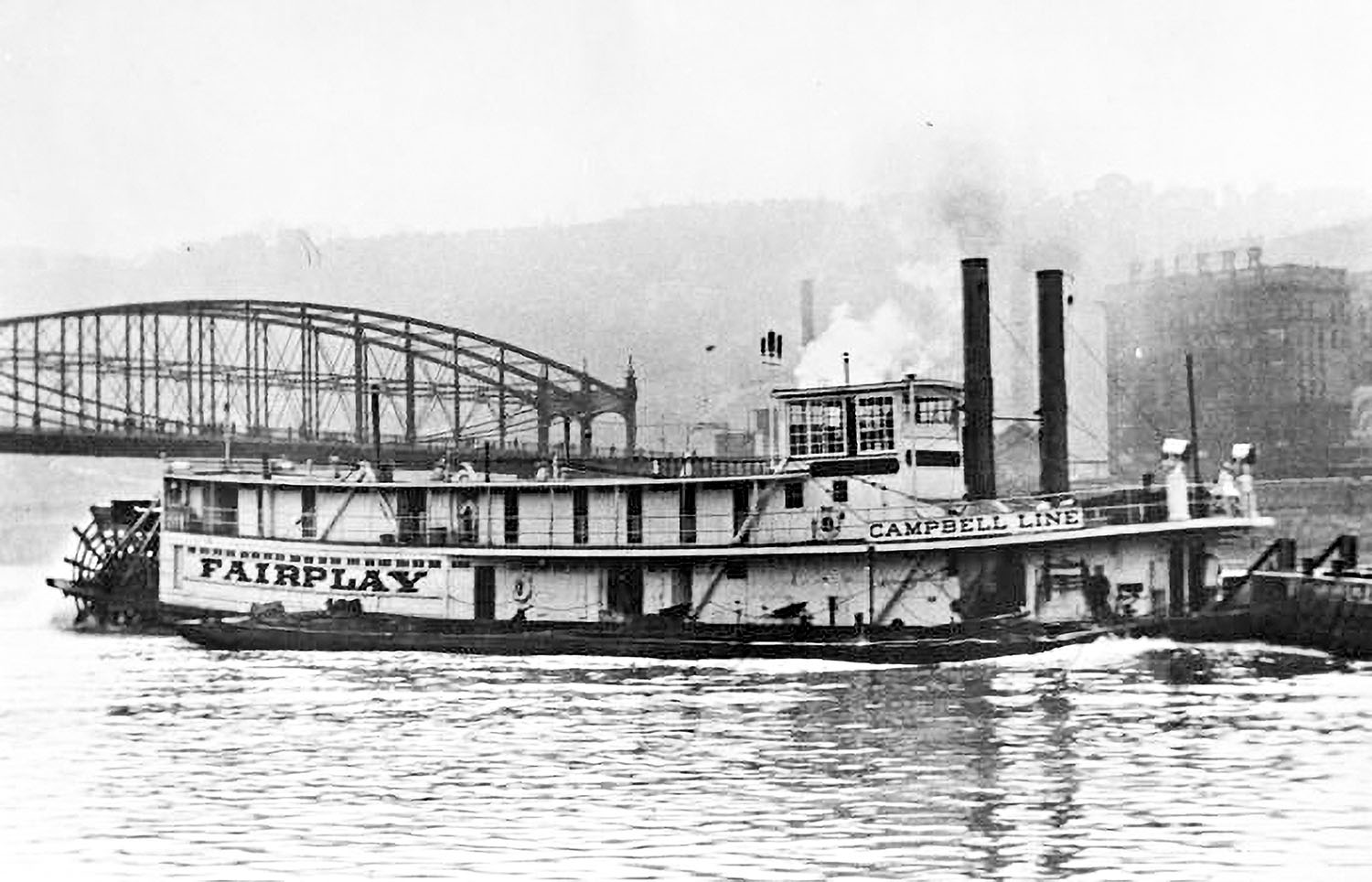The James Rees & Sons Company, with origins dating back to 1848, operated at what is now the foot of Stanwix Street on the left bank of the Allegheny River in Pittsburgh from 1854 to 1930. Originally engaged in the foundry and machine business, the firm made a transition to building vessels at the site. Notable vessels built by the company include the famous Str. Belle of Louisville, built as the Idlewild in 1914; and the Str. W.P. Snyder Jr., built as the W.H. Clingerman in 1918. Both boats survive today, more than a century after their construction. The Belle of Louisville is still running excursions at Louisville, Ky., and the Snyder is on display at the Ohio River Museum at Marietta, Ohio, where it has been a fixture since it was delivered there under its own steam in 1955.
In 1905, the Rees firm built a steam sternwheel towboat for the Jones & Laughlin Steel Company of Pittsburgh. It was the second steel-hulled boat built for J&L by Rees, and it measured 135 by 23.3 feet. The condensing engines were 12’s, 24’s – 6-foot stroke. It had three coal-fired boilers and was named Henry A. Laughlin. Way’s Steam Towboat Directory says that the boat capsized while coaling at Allenport, Pa., in 1911. It was speculated that this happened due to the narrow width of the hull. It was returned to Rees for rebuilding, but the width remained the same.
In 1931, J&L had a steam prop towboat built by Wards at Charleston, W.Va., which it named Henry A. Laughlin; preparatory to this, the name of the original was changed to Shannopin in December 1930. Capt. Charles T. Campbell had sold out his interest in Union Barge Line and in April 1931 purchased the Shannopin, with which he started Campbell Transportation Company. It remained Shannopin until it was renamed Fairplay in 1932. Capt. Vernon Byrnside was hired to be master of the boat for Campbell.
Byrnside’s daughter Marjorie Burress wrote a book about her father’s river career and the family adventures as a result of it. Titled Led By The River, the book tells of Capt. Byrnside’s early years at Buffalo, W.Va., on the Kanawha River, his eventual employment aboard the Str. Plymouth as a cabin boy, decking on the first J.T. Hatfield and a move to Pittsburgh, where he became a mate and later pilot aboard towboats in the Pittsburgh pools. He was working for Hillman Transportation when the effects of the Great Depression caused his boat to tie up, and he was laid off. Byrnside’s boss at Hillman, Capt. John L. Howder, recommended him to Campbell, who then hired him for his new purchase.
The Shannopin was working on a contract to the Gulf Oil Company, first towing gasoline from a Gulf refinery near Pittsburgh and then later from a new Gulf refinery that was constructed at North Bend, Ohio. After the boat became the Fairplay and the work was becoming steady, Byrnside moved his family to North Bend. Marjorie Burress would live the remainder of her life there and in her book credited the Fairplay with leading the family to that area. She featured a photo of the boat on the front cover as well as on the last page.
The Gulf trade saw the boat towing upstream as far as Huntington, W.Va., and as far south as Memphis on the Lower Mississippi. In 1933, the Fairplay had the misfortune to sink in the vicinity of Highland Rocks, near Ohio River Lock 49. It sank in shallow water and was raised and repaired. In the summer of 1935, the boat was taken to Dravo at Neville Island, Pa., where sponsons were added to the hull. This increased the width of the hull from 23.3 feet to 27.7 feet. A story in The Waterways Journal indicated that this was done to meet new stability requirements that had just gone into effect.
The June 8, 1935, issue of the WJ carried a lead story about the Fairplay delivering the first tow of Gulf gasoline to Nashville, Tenn., on May 25. It was described as “the largest tow of gasoline and kerosene ever towed on the Cumberland.” It was made up of four barges totaling some 2,800 tons of cargo. The trip had taken 60 hours from the North Bend refinery. Byrnside was aboard as master with Capt. Hugh Crouse and Capt. Nelson Broadfoot, pilots. Capt. Charles T. Campbell met the boat at Nashville.
Byrnside would be on the Fairplay until the new steamers John W. Hubbard and Charles T. Campbell were built by Dravo in 1936. He was with Campbell through the merger of that company with the Mississippi Valley Barge Line in 1941. The Fairplay was sold at that time to Hillman Transportation and renamed John L. Howder. It was again sold in 1945 to Crain Bros., Pittsburgh, and named Allegheny. They used it for local towing in the Pittsburgh area until it was dismantled in the fall of 1950.
Byrnside was on the John W. Hubbard and Charles T. Campbell until they were sold to The Ohio River Company in 1947. He then brought the brand-new Frank C. Rand out of Dravo for the Valley Line. In 1950, he went to work for Ohio Barge Line. There he was on the steam sternwheel Monongahela and later the DPC steam towboats operated by OBL. When the new 4,320 hp. Steel Ranger (today the Alan P. Hall for Amherst Madison), vanguard of a new fleet of diesel boats for OBL, was built by Dravo in 1965, Byrnside was the first master.
He retired in 1973, and this writer was privileged to meet him shortly after at Catlettsburg, Ky., while he was tripping on the Frances Anne for G&C Towing.



